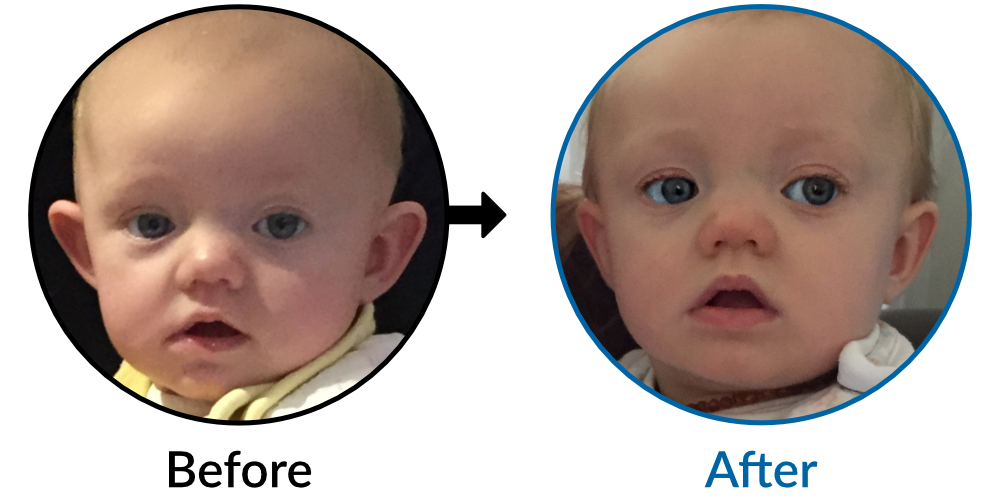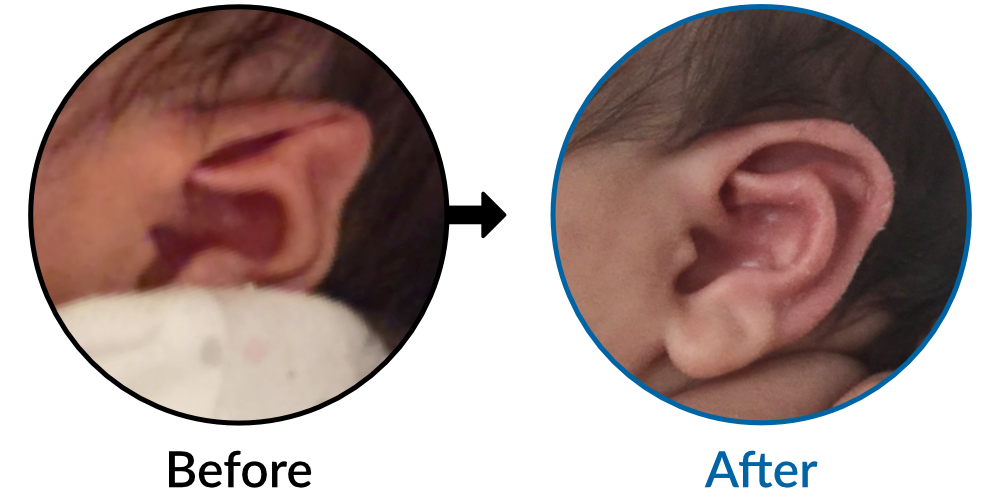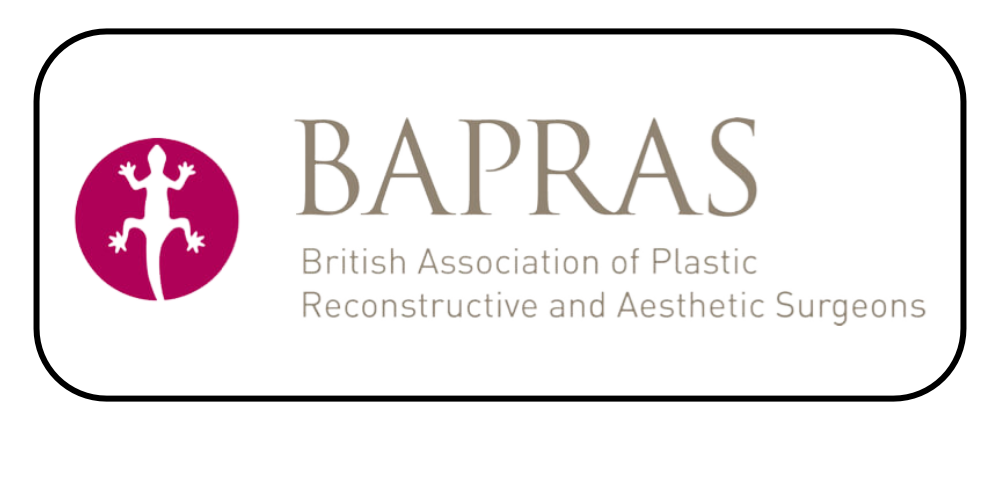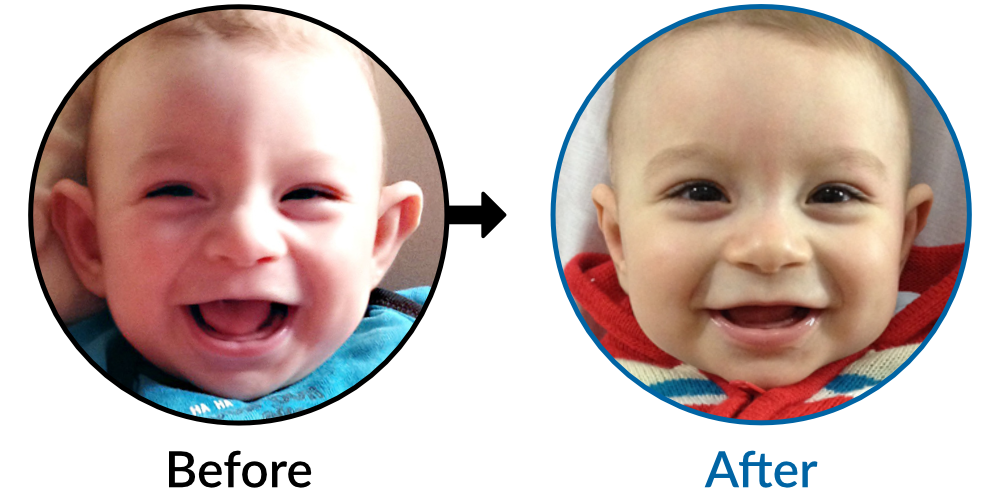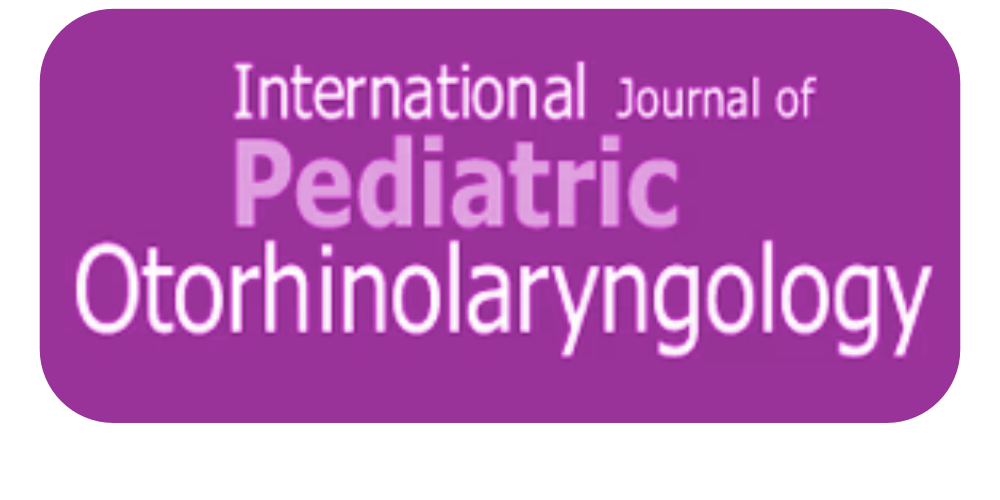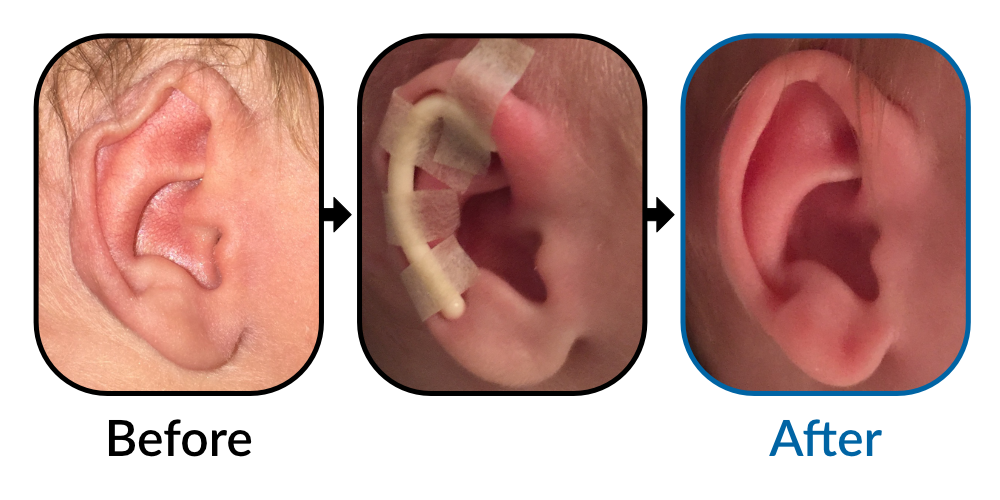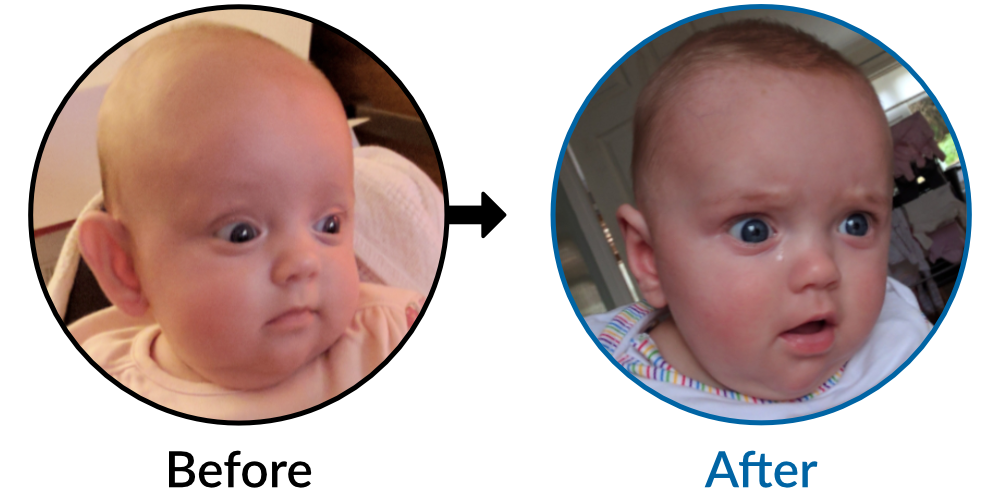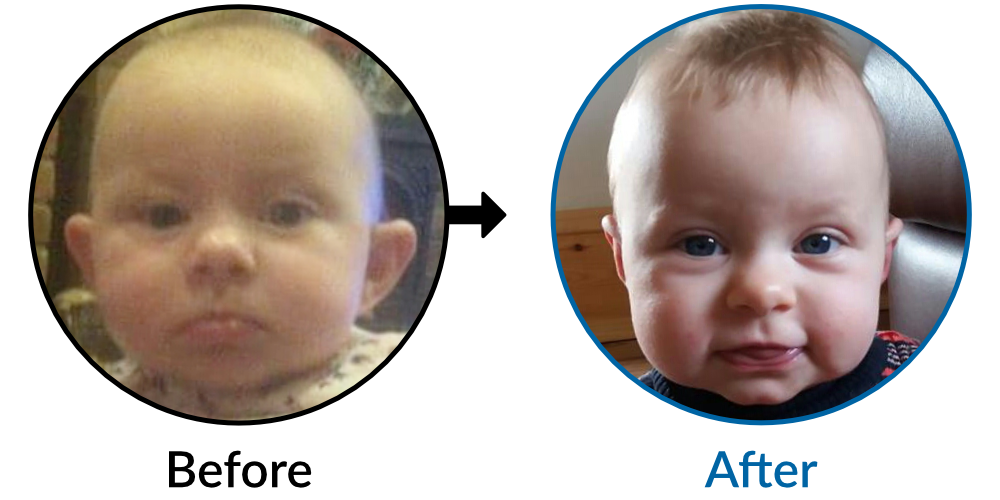Plastic Surgeon and world-renowned ear expert David Gault FRCS first published the results of his splintage technique in 1994. Since then, Early Ear Correction™ has gathered support from independent sources around the world as a way to avoid the psychological problems that go with ear deformities, and the surgery required to correct them.
 Home
Home  What the Experts Say
What the Experts Say
What the Experts Say

"EarBuddies have been available for 30 years, and worldwide for 25 years, but far too often, parents are falsely reassured that their baby's ears will get better without treatment. The very opposite is usually the case – the ears can look normal at birth, and parents are relieved, especially if there is a family history, but over the next three to six months, as the ear cartilage starts to harden, the ears slowly drift outwards. Often it's a chance comment by a friend or relative that draws parents' attention to what can be a lifetime source of embarrassment if uncorrected. Early Ear Correction with EarBuddies offers a real chance to avoid an operation, and all the teasing that comes before it. If EarBuddies splints are used early, sticking-out or odd-looking ears can become a thing of the past."
Medical Evidence

Neonatal ear splinting for congenital ear deformities, Journal of Plastic, Reconstructive & Aesthetic Surgery May 2020
Go to the article
"Splinting of ears in neonates to correct the congenital auricular deformities has been well described. Despite being a non-invasive technique and having a potential to prevent need for correctional surgery, its up-take across the UK has been poor.
The retrospective study of patients undergoing neonatal ear splinting from 2009- 2015 was conducted at the Welsh Centre for Burns and Plastic Surgery. A total of 82 (n = 123 ears) neonates were treated. At the cessation of treatment 93% were reported as improved/excellent by a clinician. Longer-term parent evaluation showed improved/excellent result in 78.89%.
Neonatal ear splinting is relatively inexpensive and has a high rate of success for a variety of neonatal ear deformities. Promoting awareness, identifying patients early and commencing treatment may reduce surgical correction of auricular deformities."

Professor John Harper, Consultant Paediatric Dermatologist, The Portland Hospital, London 2015
"I saw this 8 month old boy for review ... I was very impressed with his ear splinting which seems to have helped significantly."

Dr Jane Collins, Chief Executive and Honorary Consultant Paediatrician, Great Ormond Street Hospital, The Times 2006
"Many ear deformities can be corrected at birth by a splintage device, which is essentially what EarBuddies provides. The cartilage in the ear is floppy at birth because of the effect of oestrogen, a hormone produced by the mother, on its structure. It slowly hardens into adulthood but this happens most rapidly between birth and one year. During this period, splintage can work really well. In a newborn it can correct a deformed or sticking-out ear within two weeks; in a three-month-old within ten weeks. At birth, the sweat and oil glands of the skin are poorly developed, so the tapes needed for splintage stick well, the baby barely moves and the cartilage is highly re-mouldable. Without any treatment, a prominent ear can become worse as a baby begins to turn his head and catch it on his shoulder. The older the child, the more difficult the splintage."
"Splints are comfortable and children usually tolerate them surprisingly well. Failing this, surgery is best left until after 5 to allow the cartilage to harden enough to hold the stitches. If you are interested in trying splints, ask your GP for a referral to your nearest paediatric plastic surgeon. EarBuddies are available on the NHS in some plastic surgery units."

L. Fraser et al. / International Journal of Pediatric Otorhinolaryngology, Volume 77, Issue 4, April 2013, pg. 538–543 - NHS Royal Hospital for Sick Children, Glasgow - February, 2013 - Development of a screening service for neonatal ear deformity
Go to the article
"the introduction of routine screening and splinting on a wider basis will avoid the psychological burden of ear deformity in childhood and also avoid the need for later corrective surgery."
"Early splinting of neonatal ear deformities has been proven to be successful but the opportunity to splint is frequently missed due to lack of awareness amongst healthcare personnel."
"78% of parents rated the efficacy of splints as either excellent or very good and 96% said they would recommend the service to a friend."
"Cost analysis revealed a saving of £482.76 per child when comparing splint treatment to potential later corrective ear surgery costs."

Royal College of Surgeons, Commissioning Guidelines for Pinnaplasty, December 2013
Go to the article
"When correctly applied and well tolerated, they can reduce ear prominence. They are most effective in the neonatal period, during which time the cartilage is malleable. Their effectiveness declines in time and they should therefore be applied as early as possible."
"Information should be provided by those advising the parents of babies (GPs, Health Visitors etc) e.g. at the time of their first hearing test of the availability of such devices."
"The avoidance of surgery at a later date is a clear benefit for the individual. Their cost being significantly less than that of surgery is also of importance."

Patient.info - Prominent Ears
Go to the article
"Ear splintage can be a very effective technique for treatment of neonates with deformational auricular anomalies. The psychological distress caused by prominent ears can be considerable. The main clinical significance of prominent ears is the aesthetic problems, which can lead to a reduced quality of life, reduced self-esteem, social avoidance behaviour and poor performance in school. Teasing at school causes both short-term unhappiness and a potential long-term impact on perception of self-image and self-worth. Children and adults alike with ears that stick out may experience a damaged psyche secondary to outside ridicule and self-criticism."

Post-partum splinting of ear deformities - Lindford AJ, Hettiaratchy S, Schonauer F.
British Medical Journal 17 Feb 2007, Volume 334
"It is vital that neonatal paediatricians, obstetricians, general practitioners, and midwives are educated about early detection [of ear deformity] and how to initiate treatment themselves."
"If successful, an effective splinting programme could consign the surgical correction of all but the most severe ear deformities to the past."

Royal College of Midwives: A smart start
Midwives magazine: February/March 2008
Go to the article
"Despite the prevalence of babies born with ‘bat’ ears, pinnaplasty rates have fallen. Recent figures confirm that pinnaplasty surgery is becoming less common in Scottish children (Chan and Stewart, 2007). They echo the most recent audit of the British Association of Aesthetic Plastic Surgeons that showed all types of cosmetic procedure had increased with the exception of pinnaplasty, which had decreased by 20% during the same period. Since 1996, treatment of misshapen or prominent ears at birth using EarBuddies splints has become increasingly popular (Tan et al, 1994). Around 15,000 ears have been splinted in the last ten years, and it is highly likely that this has had some influence in reducing the number of pinnaplasty procedures performed (Fiumara and Gault, in press). "
"Many parents are told erroneously that their newborn’s ears are best left until the age of five when surgery can be performed. Others are told it will improve with age, or that simple taping will work, when in fact the opposite is true. Odd-shaped ears, which do not become completely normal in appearance within 48 hours of birth should be splinted."
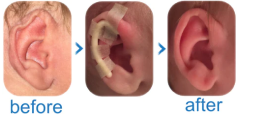
Mr. O, NHS Doctor, United Kingdom
"I would just like to provide some very positive anonymous feedback please from myself and my wife who are both health care professionals in the NHS. Your product is effective, easy to use and was really well tolerated by our new born son. I would suggest raising awareness of this great product with paediatric trainees who do the baby checks of new borns in hospital, midwifes and health visitors. For example, do you have a rep who visits maternity units? GPs should also be aware but don't typically see babies until 6-weeks. Our experience was that no health care professional we met knew anything about this treatment and we had to research this problem ourselves. The Fraser et al paper "Development of a screening service for neonatal ear deformity using neonatal hearing screeners and an information leaflet" in International Journal of Pediatric Otorhinolaryngology in 2013 gave us the confidence to go ahead with it despite nobody else we met being aware of this treatment."

Dr P Selvadurai MBBS DCH FRCPCH MSc, Consultant Community Paediatrician (Audiology), Hertfordshire Community Health Services
"Following your lecture for the BAPA, 2 years ago, I have been able to treat many newborns with hearing impairment and malformed ears with EarBuddies with such a good success and I want to thank you from the bottom of my heart to have enabled the life of these little ones easier especially for hearing aids fitting."

Non-surgical correction of congenital deformities of the auricle: A systematic review of the literature
M.P. van Wijk, C.C. Breugem, M. Kon - Journal of Plastic, Reconstructive & Aesthetic Surgery June 2009 (Vol. 62, Issue 6, Pages 727-736)
Go to the article
"Ear splinting is an elegant technique that should be practised on a wider scale than is done today."
"Surprisingly, this technique is relatively unknown to plastic surgeons and is hardly ever communicated to the general public."

Anteverted concha: A new ear deformational anomaly
Schonauer, A. Di Martino, D.T. Gault; JPRAS Open; 20 June 2015
Go to the article
"Splinting of ear deformities in the early neonatal period has been shown to be a safe and effective non-surgical treatment for many conditions, and indeed is the best treatment for some. The anteverted concha would certainly fall into the latter group."
"At the end of this period, the bulge in the concha was corrected and the external auditory meatus more open."
Rigoberto J Mendoza MD, Board Certified Plastic Surgeon, Chicago USA
"I wanted to let you know how pleased we are with the results we received on our daughter, S**, with your EarBuddies. Soon after she was born, I noticed that the cartilage in her ears were unusually soft. Specifically, when she turned her head to either side when lying down, her ears would fold in half vertically. By the time she was three months old, she was developing bat ears and losing the antihelical folds in both ears. As a physician, I attempted to correct the problem as I trained in medical school by supporting the back of the ear with rolled up gauze and taping her ear over the gauze. This worked poorly. She would tug at her ears and pull the gauze off. We also attempted to correct the problem by using headbands and caps. She would pull these off too. We also had concerns for her safety using headbands if not constantly supervised. We dreaded the thought that some day, our daughter would have to undergo surgery to correct this problem. By five months, her ears were getting worse and myself, my wife and S** were becoming increasingly frustrated with one another trying to correct the issue. Living in Chicago, we found your splints on the Internet. We ordered the splints and had it within five days. The splint is genius in its simplicity. It is very easy to use. Better yet, it didn't bother S** in the least. She never fussed to have the splint put on and taped. She never bothered with it while wearing it. The ear fold has an amazing memory. By the first tape change, around three weeks after first putting the splint on, I noticed that her antihelical folds had returned. S** began wearing the splint towards the end of the recommended age group so she wore the splint for four months. Her right ear is in perfect alignment. Her left ear, the worse of the two, is nearly perfect. I've attached a recent photo so you can see how nice her ears look. As a plastic surgeon and a father, I would not hesitate for a moment to recommend your product. My wife and I could not be more thrilled with the results."
Dr Eithne Brenner, GP
"I have used EarBuddies as a GP for several years, after discovering them 7 years ago when my second son was born with misshapen ears, which were successfully treated with splints. I have now moved permanently to Ireland and continue to use them in my practice. I think they are fantastic!"

Non-surgical correction of deformational auricular anomalies
Schonauer F, La Rusca I, Molea G: J Plast Reconstr Aesthet Surg; 2009 Jul;62(7):876-83
Go to the article
“Ear splintage is an effective technique for treatment of neonates with deformational auricular anomalies.”

ENT News
"Early splintage of pinna abnormalities in the neonatal period appears a cost effective and simple procedure which should be encouraged."
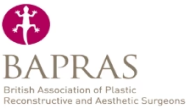
BAPRAS
Go to the article
"The cartilage in a baby’s ear is very soft and malleable, and can be moulded with the use of splints if prominent ears are obvious from birth. Splints are fitted into the outer groove (scaphoid fossa) of the ear and fixed by strips of tape, with the ear then taped to the side of the head using a broad strip of tape. The pressure of the splint corrects the tendency of the ear to stick out, while maintaining the proper contours of the ear. To be effective, splints can be required for as little as two weeks in newborn babies, or for up to four months in babies aged six months or over. However, parents should be careful with babies over the age of three months, as the splints themselves can present a choking hazard."
"Splintage is a simple, safe and non-invasive procedure for the correction of prominent ears. However, there is only a limited window of time in which splints can be effectively applied. The decision to use splints is an aesthetic decision that ultimately rests with parents."

ENT News, Vol 14, Number 6 - January/February 2006
"It should be remembered that a neonate's ears are mouldable at birth and taping back over a suitable mould ('Earbuddies') may obviate the need for surgery later in life." - Charles East, FRCS, Consultant in Rhinology & Facial Plastic Surgery, Royal National Throat, Nose & Ear Hospital, London, UK

A splint for correction of congenital ear deformities
Tan ST, Shibu M, Gault DT: British Journal of Plastic Surgery; 1994 Dec;47(8):575-8
View the abstract.
"These deformities can be treated non-surgically in the early neonatal period, effectively, without anaesthetic and with minimal cost."
"Our neonatal paediatric colleagues and midwives should be encouraged to manage these deformities in this way, and the need for surgical correction may be largely avoided in the future."

When do ears become prominent?
Tan ST, Gault DT: British Journal of Plastic Surgery; 1994 Dec;47(8) :573-4.
Go to article.
"Non-hypoplastic congenital ear deformities are amenable to non-surgical treatment with splinting in the neonatal period"
"A large number of patients with prominent ears could be treated effectively, non surgically, early in life, without anaesthetic and with minimal cost."
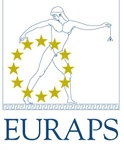
Splintage for correction of congenital ear deformities
Schonauer, Fera, La Rusca and Molea, Presented at EURAPS Vienna
Go to the article
"Excellent results were achieved in 82% of the splinted ears. In the other 18% results were satisfactory or good. No complications occurred in the series."
"Ear splintage is an effective technique that should be more frequently offered to parents of affected neonates."

Correction of deformational auricular anomalies by moulding - results of a fast-track service.
Swee Tan, Anna Wright, Anna Hemphill, Kari Ashton, Joan Evans - Journal of the New Zealand Medical Association, 12-September-2003, Vol 116 No 1181
Go to the article
"According to the parents’ assessment, complete correction or marked improvement occurred in 29 of 35 anomalous ears (83%). All parents felt that auricular moulding was worthwhile."

Nonsurgical correction of congenital auricular deformities in children older than early neonates
Yotsuyanagi T, Yokoi K, Urushidate S, Sawada Y: Plast Reconstr Surg; 1998 Apr;101(4):907-14
Go to the article
"The patients were between 1 and 14 years of age with an average age of 3.6 years .... the average period of splint application was 2.1 months .... In 27 of the 50 cases, the treated ears were excellent. Eleven ear cases showed improvement. Six cases showed recurrence. Three cases did not improve. Three patients gave up treatment."
"It is suggested that nonsurgical auricular correction is possible in almost all children, even if they are not early neonates, when corrections are made continuously and gradually."

Nonsurgical correction of congenital auricular deformities a new method of neonatal molding and splinting
Zambudio G, Guirao MJ, Sanchez JM, Giron O, Ruiz JI, Gutierrez MA:. Cir Pediatr; 2007 Jul;20(3):139-42
Go to the article

Early nonsurgical correction of congenital auricular deformities
Ullmann Y, Blazer S, Ramon Y, Blumenfeld I, Peled IJ: Plast Reconstr Surg; 2002 Mar;109(3):907-13; discussion 914-5
Go to the article

Tan ST, Abramson DL, MacDonald DM, Mulliken JB.
Molding therapy for infants with deformational auricular anomalies. Ann Plast Surg 1997;38:263–8.
Go to the article
Ear Splintage - FACE vol. 5 no. 4 pp 211-212 (1998) Kugler Publications, The Hague, The Netherlands
D. Gault - RAFT Institute of Plastic Surgery, Mount Vernon Hospital, Northwood, Middlesex, UK - Ear Splintage
Go to article

Calder JC, Naasan A. Morbidity of otoplasty: review of 562 consecutive cases. Br J Plast Surg 1994;47:170–4.
Go to the article

Matsuo K, Hirose T. A splint for non surgical correction of cryptotia. Eur J Plast Surg 1989;12:187–8.

Matsuo K, Hirose T, Tomono T, et al. Nonsurgical correction of congenital auricular deformities in the early neonate: a preliminary report. Plast Reconstr Surg 1984;73:38–51.

Matsuo K, Hayashi R, Kiyono M, et al. Nonsurgical correction of congenital auricular deformities. Clin Plast Surg 1990;17:383–95.

Bradbury ET, Hewison J, Timmons MJ. Psychological and social outcome of prominent ear correction in children. Br J Plast Surg 1992;45:97–100.
Go to the article

